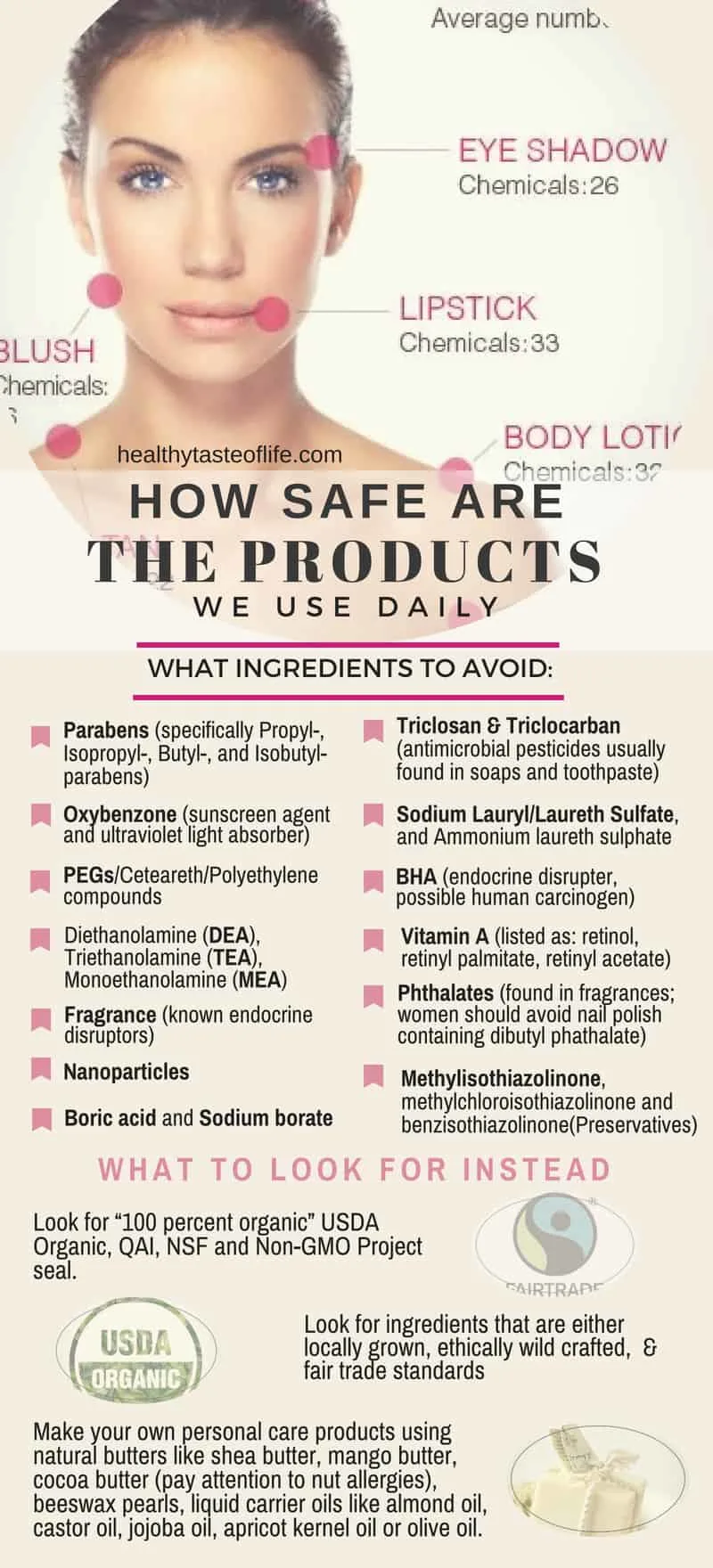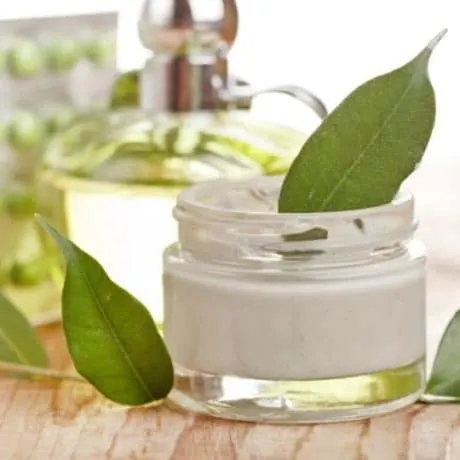
I never really considered that what I was feeding my body could possibly contribute to my complexion. I never considered how toxic makeup ingredients can be.
I used brand name cosmetics and personal products for years with seemingly no problems. With time I noticed I was having a few strange reactions.
Some popular makeup brands caused my skin to get blotchy and itchy, others caused my eyes to get extremely watery, after a while I couldn’t wear mascara anymore, it was too irritating.
Related: Choosing The Healthiest Cookware With Safest Materials
Check Cosmetics Ingredients
It is quite common for people with celiac or gluten intolerance to have skin irritations when they use makeup and skin care products made from wheat products. Food allergies can also trigger makeup sensitivity. And that’s because everything that goes on our skin is highly absorbable and may end up in our bloodstream, same principle with birth control patches. And it’s not only the food byproducts but also the types and amount of chemicals that are used in manufacture.
Some people are intolerant to the artificial colors and preservatives, you may also want to take a long look at your soaps, deodorants, perfumes and lotions. Some people, especially after a long-term or life-threatening illness, become hypersensitive to chemicals.
Liver conditions, kidney problems, and other illnesses is a result of body’s detoxing organs becoming over loaded by environmental toxins. If you fall into this category you need to change you personal care products, or if you just want to avoid all those nasty ingredients.
Probably you’re reading this thinking, I don’t even have eczema, and I don’t have allergies. Even if you don’t have cosmetic-related allergies, skin sensitivities or blemishes (caused by mineral oil- and petroleum-filled products that are clogging your pores) you should be concerned about what you’re putting on your skin – because it’s absorbed, just like the food we eat, the water we drink and the air we breathe. You are exposed to cosmetics ingredients by breathing in sprays and powders, swallowing chemicals on the lips or hands or absorbing them through the skin.
The Labeling Side Of Personal Care Products

The average woman uses 12 products containing 168 different ingredients daily and the average man uses 6 products with 85 ingredients. Given the fact that chemicals found in those ingredients are designed to penetrate deep into the skin, the consequences may include hormonal and endocrine system disruption, reproductive system disorders (play a huge role during puberty) allergic skin reactions, developmental disorders, increased skin sensitivity and even cancer. (Read more here).
You should probably already know that cosmetics companies can use any ingredient or raw material in their products without government review or approval (FDA 2005). Since FDA does little to regulate ingredient safety, it has authorized the cosmetics industry to police itself through its Cosmetics Ingredient Review panel. In its more than 30-year history, the industry panel has declared only 11 ingredients or chemical groups to be unsafe.
Even if you decided to switch to organic and natural products labeled “organic” or “natural” can contain petrochemicals, and those certified as organic can contain as little as 10 percent organic ingredients by weight or volume so truly natural or organic ingredients are not necessarily risk-free. Always check the ingredients listed on the label.
FDA does not define or regulate the term “organic,” as it applies to cosmetics, body care, or personal care products but rather as it applies to agricultural products through its National Organic Program (NOP) regulation.
Categories Of “Organic” Labeling
According to USDA, once certified, cosmetics, personal care products, and body care products are eligible for 4 organic labeling categories, based on their organic content and other factors:
- “100 percent organic” – Product must contain (excluding water and salt) only organically produced ingredients. Products may display the USDA Organic Seal and must display the certifying agent’s name and address.
- “Organic” – Product must contain at least 95 percent organically produced ingredients (excluding water and salt). Remaining product ingredients must consist of non-agricultural substances approved on the National List or non-organically produced agricultural products that are not commercially available in organic form. Products may display the USDA Organic Seal and must display the certifying agent’s name and address.
- “Made with organic ingredients” – Products contain at least 70 percent organic ingredients and product label can list up to three of the organic ingredients or “food” groups on the principal display panel. For example, body lotion made with at least 70 percent organic ingredients (excluding water and salt) and only organic herbs may be labeled either “body lotion made with organic lavender, rosemary, and chamomile,” or “body lotion made with organic herbs.” Products may not display the USDA Organic Seal and must display the certifying agent’s name and address.
- Less than 70 percent organic ingredients – Products cannot use the term “organic” anywhere on the principal display panel. However, they may identify the specific ingredients that are USDA-certified as being organically produced on the ingredients statement on the information panel. Products may not display the USDA Organic Seal and may not display a certifying agent’s name and address. (Water and salt are also excluded here.)
However, USDA has no authority over the production and labeling of cosmetics, body care products, and personal care products that are not made up of agricultural ingredients.
Also some products may be certified to other, private standards (or third-party certification) and be marketed to those private standards in the United States.
These standards might include foreign organic standards, eco-labels, earth friendly, like: ECOCERT, ECOCERT-AFRISCO, BIO-ORG, UK Soil Association, BDIH – Natural Beauty Standard, BCS, they all have their own policies and standards.
Even if there is no certification but it has “Natural” term or other type of “green” claims it makes you think is better.
Unfortunately these claims have more advertising purposes and sometimes they are less truthful or misleading.
There are no mandatory government standards established for the use of these terms (aside from the California Organic Body Care Standards).
What Ingredients To Avoid In Beauty Products

- Parabens (specifically Propyl-, Isopropyl-, Butyl-, and Isobutyl- parabens)
- Triclosan & Triclocarban (antimicrobial pesticides usually found in soaps and toothpaste)
- Formaldehyde
- Boric acid and Sodium borate
- Methylisothiazolinone, methylchloroisothiazolinone and benzisothiazolinone (Preservatives)
- Oxybenzone (sunscreen agent and ultraviolet light absorber)
- Vitamin A (listed as: retinol, retinyl palmitate, retinyl acetate)
- Phthalates (found in fragrances; women should avoid nail polish containing dibutyl phathalate)
- PEGs/Ceteareth/Polyethylene compounds
- Diethanolamine (DEA), Triethanolamine (TEA), monoethanolamine (MEA)
- Sodium Lauryl/Laureth Sulfate, and Ammonium laureth sulphate
- Nanoparticles (they can penetrate our body’s cells more easily)
- Fragrance ( it can be made up of 1, or 2, or even hundreds of chemicals, known endocrine disruptors)
- BHA (endocrine disrupter, possible human carcinogen)
Other Options Worth Considering

Ok, so my intention writing this is not to scare you and become paranoid of everything you buy but at least to make you become more aware of how this industry is deceiving us with their statements or omits information about safety claims.
I understand that we women need some sort of makeup, because we like to look pretty, so how to avoid all those risks and to enjoy your products getting the best of them?
You can search a product in a data base called EWG’s Skin Deep it is an online safety guide for cosmetics and personal care products, launched in 2004 to help people find safer products. The database provides easy-to-navigate safety ratings for tens of thousands of personal care products.
Another option is to make your own personal care products using natural butters like shea butter, mango butter, cocoa butter (pay attention to nut allergies), beeswax pearls, liquid carrier oils like almond oil, castor oil, jojoba oil, apricot kernel oil or olive oil.
Additionally you can infuse different healing herbs in your oils as well and essential oils that will give a great natural scent besides the healing properties they will provide.
Some of the best essential oils used for body care are:
- lavender (regenerates skin cells)
- chamomile (calms down irritation)
- yarrow (anti-inflammatory, cicatrisant)
- lemon (rejuvenates sagging or tired-looking skin)
- mint (antiseptic and antimicrobial, good for washing products)
- frankincense (encourages new cell growth, tighten skin and reduce wrinkles, scars)
- geranium (antiparasitic, regulates oil production, good for acne)
- rose (great for aging skin)
- tea tree (healing, antibacterial)
- myrrh (anti-inflammatory, healing, regenerating).
Mixing them in different combinations you can get such an aroma which you can’t even imagine.
Usually those powerful artificial fragrances are designed to cover up the smell of other chemicals, the effect is that you have a chemical to cover up another chemical.
The good news is there are a ton of great new natural beauty products on the market. These products use natural preservatives, such as grapefruit seed extract, that won’t affect your body. And while some people have allergies to a few natural ingredients (lanolin, which comes from wool, bee wax or nut butters) the effects are much more understood and easily identified than the ones from synthetic ingredients.
Read More:
What To Look For In A Shampoo | What Ingredients To Avoid
Skin Healing And Regenerating Whipped Body Butter Recipe
How to Remove Makeup Naturally
[mailerlite_form form_id=5]


jasques
Sunday 21st of October 2018
It is a nice and helpful piece of information. I am glad that you just shared this useful info with us. Please keep us up to date like this. Thanks for sharing.